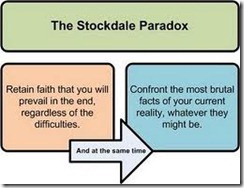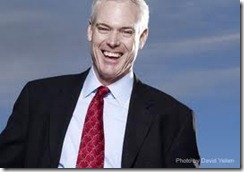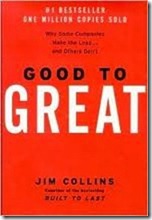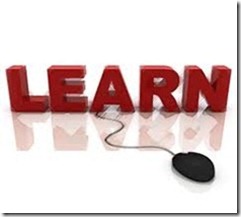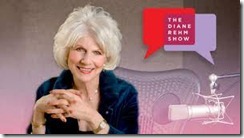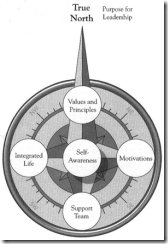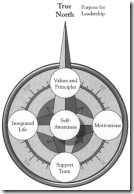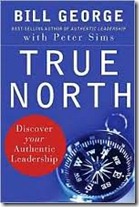 This post about the Hedgehog Concept continues our 8-part series on Good to Great
This post about the Hedgehog Concept continues our 8-part series on Good to Great
Jim Collins and his team discovered the Hedgehog Concept researching Good to Great. It remains one of my favorite concepts of the book. I consider it one of the most powerful applications. My description will briefly introduce you to the concept. As always, I strongly encourage you to read the book yourself and study its contents carefully. You will find the quotes I use in today’s blog in Chapter 5 of Good to Great.
Are You a Hedgehog or a Fox?
Collins begins the chapter reviewing Isaiah Berlins’ essay on The Hedgehog and the Fox. In the essay the fox tries a variety of methods to catch the hedgehog. Each day he must create a new method. Each day he fails. The hedgehog, however, does one thing and does it repeatedly. He rolls himself into a ball with his spiny quills exposed to the fox’s mouth. The hedgehog’s single-minded application to the same approach saves his life.
The author illustrates the application of the hedgehog concept in business with how Walgreen’s became a dominant player in the convenience drug store industry. (Read pages 92-93 to understand Walgreen’s hedgehog concept.) Collin's continues “Those who built the good-to-great companies were, to one degree of another hedgehogs. They used their hedgehog nature to drive toward what we call a Hedgehog Concept for their companies. Those who led the comparison companies tended to be foxes, never gaining the clarifying advantage of a Hedgehog Concept, being instead scattered, diffused, and inconsistent.”
Find Your Hedgehog Concept Where 3 Circles Intersect
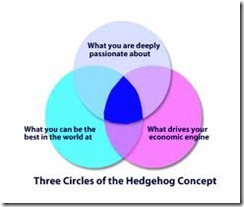 “The essential strategic difference between the good-to-great and comparison companies” writes Collins “lay in two fundamental distinctions. First, the good-to-great companies founded their strategies on deep understanding along three key dimensions—what we came to call the three circles. Second, the good-to-great companies translated that understanding into a simple, crystalline concept that guided all their efforts—hence the term Hedgehog Concept.”
“The essential strategic difference between the good-to-great and comparison companies” writes Collins “lay in two fundamental distinctions. First, the good-to-great companies founded their strategies on deep understanding along three key dimensions—what we came to call the three circles. Second, the good-to-great companies translated that understanding into a simple, crystalline concept that guided all their efforts—hence the term Hedgehog Concept.”
The circles include:
- “What can you be the best in the world at (and, equally important, what you cannot be the best in the world at).
- What drives your economic engine: All the good-to-great companies attained piercing insight into how to most effectively generate sustained and robust cash flow and profitability.
- What are you deeply passionate about: The good-to-great companies focused on those activities that ignited their passion.
Your hedgehog concept exists where the three circles intersect. Jim Collins applies the hedgehog concept to you personally on pages 96-97. Read it a couple of times to see how it can improve your career satisfaction.
“The hedgehog concept is a turning point in the journey from good to great. In most cases, the transition date follows within a few years of the Hedgehog Concept. Furthermore, everything from here on out in the book hinges upon having the Hedgehog Concept. As will become abundantly clear in the following chapters, disciplined action-0-the third big chunk in the framework after disciplined people and disciplining thought—only makes sense in the context of the Hedgehog Concept.”
Use a Council (Mastermind Group) to Find Your Hedgehog
Collins wrote “One particularly useful mechanism for moving the process along is a device that we came to call the Council. The Council consists of a group of the right people who participate in dialogue and debate guided by the three circles, iteratively and over time, about vital issues and decisions facing the organization.”
“In response to the question, ‘How would we go about getting our Hedgehog Concept?’ I would point to the diagram on page 114 and say ‘Build the Council, and use that as a model. Ask the right questions, engage in vigorous debate, make decisions, autopsy the results, and learn—all guided within the context of the three circles. Just keep going through that cycle of understanding.”
Once again, I encourage you to study chapter 5 of Good to Great, form your own council, and work through the process until you find your Hedgehog Concept. It will prove the turning point to turning your career (or organization) from good to great.
Join us on Friday to learn how to create a culture of discipline within your life or organization
